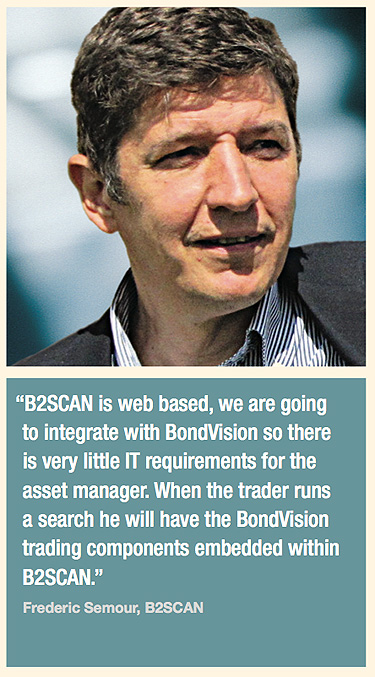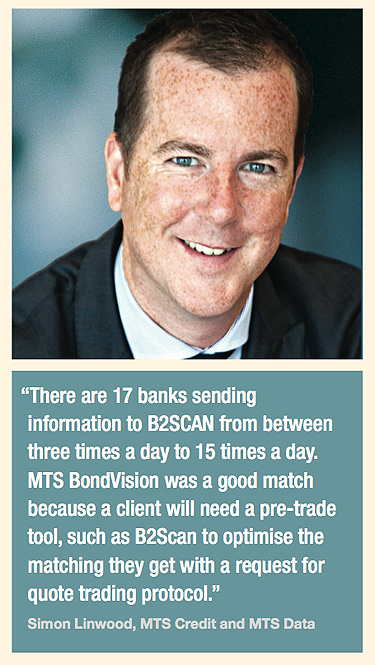MTS BondVision and B2SCAN are partnering to streamline the process of execution in corporate bonds. By combining liquidity discovery with order matching, the trading platform and technology provider are able to give access to 10,000 issues covering corporates, financials, covered and agency.
Simon Linwood, Head of MTS Credit and MTS Data and Frederic Semour, founder at B2SCAN gave their perspective on the new model and its implications for fixed income traders at buy- and sell-side firms. Laurent Albert, Head of Global Trading at Natixis Asset Management Finance and Brett Chappell, Global Head of Trading at Nordea Investment Managers, also offer their views as buy and sell-side participants.
What are the stages of the liquidity discovery process in the credit market at present and how has that changed over the last five years?
 Frederic Semour: Much of the process is not very sophisticated and remains limited. For example, firms will ask German banks for German names and Spanish banks for Spanish names. Most fund managers will receive Excel spreadsheets from dealers or search for counterparties via their Bloomberg screen. If there is no response from the first six names then they will try another six, which is often a time-consuming process for participants wishing to execute efficiently and at the best price. However, this can also be problematic because some banks don’t put all of their inventory on Bloomberg for confidentiality reasons. Very few asset managers have gone through the pain of developing proper systems which give them a very comprehensive view of the market.
Frederic Semour: Much of the process is not very sophisticated and remains limited. For example, firms will ask German banks for German names and Spanish banks for Spanish names. Most fund managers will receive Excel spreadsheets from dealers or search for counterparties via their Bloomberg screen. If there is no response from the first six names then they will try another six, which is often a time-consuming process for participants wishing to execute efficiently and at the best price. However, this can also be problematic because some banks don’t put all of their inventory on Bloomberg for confidentiality reasons. Very few asset managers have gone through the pain of developing proper systems which give them a very comprehensive view of the market.
Simon Linwood: Regulation has severely impacted what the banks can do, not only in balance sheet capacity but also in their internal distribution. On the dealer side they will reference their balance sheet reducing to 20 per cent of what it was five years ago, but they are also struggling to take large clips in from the buy-side. It is in part due to that 20 per cent, but also because they haven’t got the internal desks to unwind spin positions off effectively, or at least cut down their size of that position. They used to have an asset management desk, a treasury desk and a prop desk where they could probably cross 75 per cent of that position and then carry the residual 25 per cent position on their books.
Banks have simply cut down on the number of bonds they are willing to price. On a Bloomberg screen, an MTS screen or a Tradeweb screen for instance, you can see a lot of banks posting prices in a lot of bonds but they are not necessarily going to respond to every enquiry or to every request for quote. That’s why the asset managers are using Fred’s example and going to the French banks for French telcos or French autos, because they haven’t got enough pre-trade information to know which bank they should be speaking to.
Laurent Albert: As credit liquidity has grown scarce in recent years, the market has looked to technology providers such as MTS and B2SCAN to deliver the innovation required to tackle this very complex challenge. Enabling the buy-side community to search sell-side axes will open up a whole new pool of trading opportunities, significantly increasing our credit trading activity across the board.
How is the B2SCAN and MTS initiative going to fit into that process?
Frederic Semour: When you work on the buy-side the issue is that you do not know where the bonds are. You don’t know who to call for a bond, and while you can call French banks on French names, the 20 million position you are looking for may be held by a German bank or a Spanish bank who you wouldn’t think of calling.
Crucially, the search engine technology delivers real colour on price in the market by providing the buy-side with a comprehensive view of inventories and positions held by major dealers.
 Simon Linwood: B2SCAN has access to the dealer inventory for 17 dealers and the buy-side can effectively use those B2SCAN tools to see where banks are axed. Execution traders get a lot of pre-trade information on the desk, or a portfolio manager can use B2SCAN for asset allocation, to determine which bonds they are looking to potentially put into their portfolios. B2SCAN holds an enormous amount of valuable pre-trade data, while MTS BondVision offers the execution protocol allowing the trade to be landed on a regulated multilateral trading facility (MTF).
Simon Linwood: B2SCAN has access to the dealer inventory for 17 dealers and the buy-side can effectively use those B2SCAN tools to see where banks are axed. Execution traders get a lot of pre-trade information on the desk, or a portfolio manager can use B2SCAN for asset allocation, to determine which bonds they are looking to potentially put into their portfolios. B2SCAN holds an enormous amount of valuable pre-trade data, while MTS BondVision offers the execution protocol allowing the trade to be landed on a regulated multilateral trading facility (MTF).
B2SCAN collects inventories from all the banks, one-sided positions, the bids and offers on all given bonds, and then gives the buy-side clients a search engine. So they can specify a search for Spanish corporates, single A-rating minimum and 500 million outstanding amounts minimum, and they will have all the offers and all the bids that corresponds to that criteria.
There are 17 banks sending information to B2SCAN from between three times a day to 15 times a day. MTS BondVision was a good match because a client will need a pre-trade tool, such as B2SCAN to optimise the matching they get with a request for quote trading protocol.
Currently traders can look for a bond and in the same way that Amazon will propose other items you might wish to buy when you are shopping, the trader will see a range of other bonds proposed. They make their choice and then execute.
We are currently building a tool that would offer the trading capacity on B2SCAN so the client would log in, then search at a simple level just using an ISIN code or run a more sophisticated search using multiple criteria. Once he has found the bond he can execute directly on BondVision, which already has terrific relationships with a lot of big asset managers.
Brett Chappell: Electronic trading continues to transform the fixed income landscape as the efficiencies it delivers appeal to participants on both the buy- and sell-side. The initiative between MTS and B2SCAN will further increase efficiency, for buy-side traders, by dramatically cutting down the time it takes them to identify a counterparty for the credit products they want to trade.
From a technical point of view how do the components interact?
Frederic Semour: B2SCAN is web based, we are going to integrate with BondVision so there is very little IT requirements for the asset manager. When the trader runs a search he will have the BondVision trading components embedded within B2SCAN.
Once he finds the bond that he wants to buy or sell, and can see there is 5 million with one bank, 5 million with another and at the bottom of that page, he can trade as if he was using BondVision. That’s how it works.
Simon Linwood: We also see integration with order management systems (OMSs) as crucial. We have had a lot of interest from buy-side, sell-side and OMS providers and are working out how data would stream across each system. The most important thing is to make this as seamless and easy as possible. The fewer number of clicks, the more likely the platform will see the trade.
We are talking to the OMS providers and asset managers about how they want the workflow process to operate. BondVision itself is looking at the development of interoperability with B2SCAN which is similar to the way we link with an OMS.
What should a buy-side trader do to take advantage of this initiative?
Simon Linwood: To start, to they need to sign the contract for B2SCAN which is extremely light and the banks will then enable the client to see their data. If they are not already on BondVision then they should sign with us, which may involve bringing in the OMS and over the last 25 we have established connectivity with all of the major OMS providers.
How do sell-side firms perceive the offering?
Frederic Semour: The market maker is happy because he is able to get rid of bonds held on inventory to make money; the salesman is very happy because he is getting a trade from a client on a bond that he owns so his relationship with the trader is better – he doesn’t have the aggravation of asking his own trader to go short on a bond that the trader doesn’t want to go short on.
Simon Linwood: Banks always control which accounts can see their data. On B2SCAN they do not send out blanket information, it’s the dealers who permission the account and that was extremely important to us.
Frederic Semour: The client is happy because he has had the best price and he hasn’t spent half an hour looking for the bond. He is not calling 10 people to get a bid or get an offer, telling the whole market what he is doing. He is working in a very discreet way and keeping information leakage to a minimum.
Simon Linwood: Using that example we are facilitating the smooth execution of a trade, pleasing the trader, the salesperson and the buy-side. What our initiative is trying to do now is to put that onto an electronic platform because at the moment most of that is still done on voice. That’s where the novation to an electronic platform can help.
B2SCAN allows the trader select the axed banks as the first part of the RFQ process, you could then look at adding one or two lead managers, then maybe a bank that you know is a specialist or has a really good trader in that particular sector so it’s a way of improving the RFQ selection process and delivering best execution.
Frederic Semour: To summarise, B2SCAN is giving the trader some real colour on prices in the market through its search engine functionality, and in doing so is really surpassing the capabilities of voice trading, while simultaneously cutting information leakage. When combined with BondVision the trader gains efficient pre-trade liquidity discovery with orderly and efficient execution in the dealer to client market.
©TheDESK 2017
©Markets Media Europe 2025












